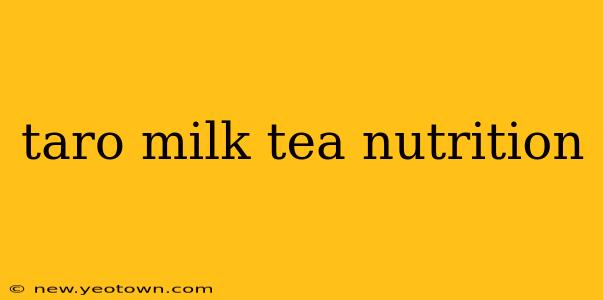Taro milk tea. The name itself conjures images of creamy, subtly sweet indulgence. But beyond the delightful taste, what's actually in this popular beverage? Let's embark on a delicious journey to uncover the nutritional facts and address some common questions surrounding this beloved drink. This isn't just about calories; we'll explore the good, the bad, and the surprisingly interesting aspects of taro milk tea's nutritional profile.
What are the main ingredients in taro milk tea?
At its heart, taro milk tea is a harmonious blend of several key components. The star, of course, is the taro – a root vegetable with a unique, slightly sweet flavor and a surprisingly creamy texture when cooked. This is then blended with milk (often dairy, but increasingly plant-based alternatives are available), tea (usually black tea, providing a subtle bitterness that balances the sweetness), and sweetener (often sugar, but also honey or artificial sweeteners). The exact proportions and specific ingredients can vary widely depending on the brand and preparation method, leading to significant differences in the nutritional content.
How many calories are in a typical serving of taro milk tea?
This is where things get a little tricky. The calorie count can fluctuate dramatically, depending on the size of the serving, the type of milk used, and the amount of added sugar. A small taro milk tea might clock in around 200-300 calories, while larger, sweeter versions could easily surpass 500 calories. Think of it like this: a small, less sugary version is akin to a light dessert; a large, sugary one is a substantial treat. Always check the nutritional information provided by the specific vendor if available, as this is your best guide.
Is taro milk tea healthy?
The "healthy" label is a bit of a stretch for taro milk tea, primarily due to the sugar content. While taro itself offers some nutritional benefits – it's a source of fiber and certain vitamins and minerals – these benefits are often overshadowed by the substantial sugar and potentially high fat content from the milk. Moderation is key. Occasional enjoyment is fine, but making it a regular part of your daily diet could contribute to weight gain and other health issues associated with excessive sugar intake.
What are the nutritional benefits of taro?
Let's give taro its due. While the milk tea version might not be a health powerhouse, taro itself boasts some nutritional advantages. It’s a decent source of dietary fiber, which aids digestion and can contribute to feelings of fullness. It also provides some vitamin C, vitamin B6, and potassium. These nutrients are essential for various bodily functions, from immune support to maintaining healthy blood pressure.
What are the downsides of drinking taro milk tea regularly?
Regular consumption of taro milk tea, particularly the sweeter, larger versions, can lead to several potential downsides. The high sugar content can contribute to weight gain, increased risk of type 2 diabetes, and dental problems. The high calorie count, if not balanced with sufficient physical activity, can also lead to weight management difficulties. Additionally, the type of milk used can impact the overall fat and saturated fat content, further influencing the drink’s overall health profile.
Can I make healthier taro milk tea at home?
Absolutely! Making your own taro milk tea gives you complete control over the ingredients. Opt for unsweetened or lightly sweetened options, use a lower-fat milk (or plant-based milk alternatives), and adjust the sugar to your liking. You can even reduce the amount of milk used to create a less creamy, lower-calorie version. Experimenting with spices like cinnamon or cardamom can also add flavor complexity without relying on excessive sugar.
Are there any alternatives to taro milk tea?
If you're looking for a similarly delicious but potentially healthier beverage, consider exploring alternatives. Fruit-infused teas, herbal teas with a splash of milk, or even smoothies made with taro and other fruits can offer similar creamy textures and satisfying flavors with fewer calories and sugar. The key is to find a balance between taste and nutrition.
The journey through the world of taro milk tea nutrition is a reminder that balance is key. Enjoy this delightful drink occasionally, but be mindful of its calorie and sugar content, and don't hesitate to explore healthier alternatives or make your own at home for greater control. Ultimately, informed choices pave the way for a healthier and happier relationship with your favorite beverages.

